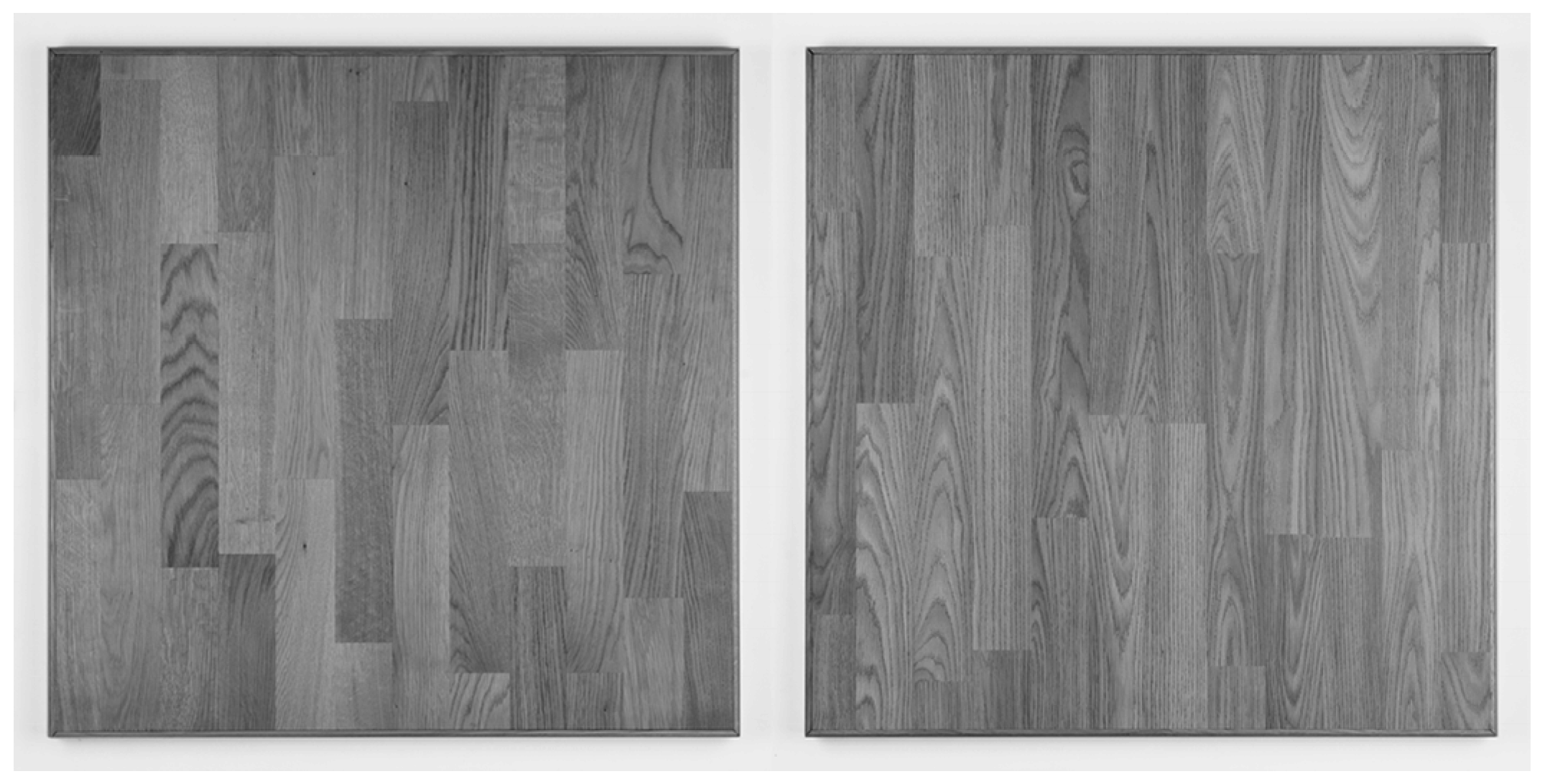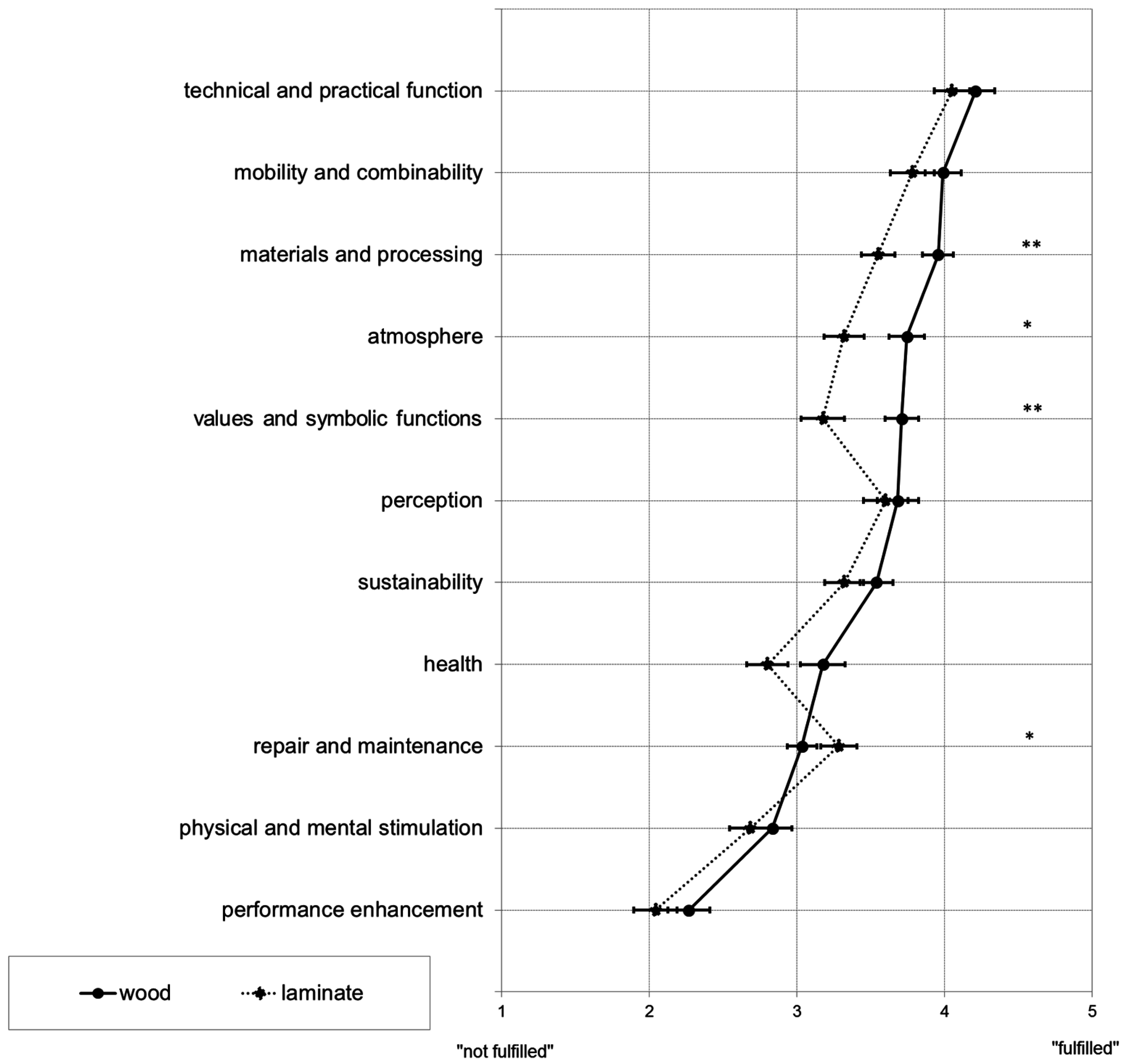Wood or Laminate?—Psychological Research of Customer Expectations
Abstract
:1. Introduction
1.1. Psychological Attributes of Materials
1.2. Psychological Attributes of Wood and Wood Products
1.3. Psychological Differences between Wood and Laminate
1.4. Research Aims
2. Materials and Methods
2.1. Research Design
2.2. Participants
2.3. Measures
2.4. Procedure
2.5. Statistical Methods
3. Results
3.1. Quality Criteria of Green Products (QCC-Green)
3.2. Purchase Decision with Wood and Laminate Products
4. Discussion
5. Conclusions
Acknowledgments
Author Contributions
Conflicts of Interest
Appendix A
| Dimension | α | Item |
|---|---|---|
| sustainability | 0.81 | The material used for this product has a good CO2 balance. |
| The material used for this product is environmentally friendly. | ||
| The material used for this product can be easily reused. | ||
| The product is durable. | ||
| materials and processing | 0.79 | The material used for this product is stable and resistant. |
| Due to its properties, the used material is suited for this product. | ||
| The material used for this product shows high quality. | ||
| The product is produced with high standards of craftsmanship. | ||
| technical and practical function | 0.84 | The product is safe and harmless. |
| The product is easy to manage and convenient. | ||
| The product meets practical needs. | ||
| repair and maintenance | 0.67 | The product is easy to maintain. |
| Even as a non-expert, the product can be fixed easily. | ||
| Maintenance and care of this product requires little time. | ||
| perception | 0.90 | The design of the product is aesthetically appealing. |
| The surface design is visually appealing. | ||
| The product appears to be inviting. | ||
| atmosphere | 0.85 | The product appears to be warm and comfortable. |
| The product creates a pleasant room atmosphere. | ||
| The product blends harmoniously into the overall room design. | ||
| The product positively influences the indoor climate (humidity, temperature, …). | ||
| mobility and combinability | 0.92 | The product can be combined easily with other materials/products. |
| The product also fits well into other rooms. | ||
| health | 0.92 | The product raises well-being. |
| The product appears to be stress-reducing. | ||
| The product improves life quality. | ||
| physical and mental stimulation | 0.92 | The product appears to be activating. |
| The product appears to be calming. | ||
| The product has a positive effect on the inner balance. | ||
| performance enhancement | 0.93 | The product supports productivity. |
| The product promotes communication. | ||
| The product stimulates creativity and imagination. | ||
| values and symbolic functions | 0.75 | The product appears to be natural. |
| The product is modern. | ||
| The product is exclusive. |
References
- Nyrud, A.; Bysheim, K.; Bringslimark, T. Health benefits from wood interiors in a hospital room. In Proceedings of the International Convention of Society of Wood Science and Technology and United Nations Economic Commission for Europe, Geneva, Switzerland, 11–14 October 2010.
- Rametsteiner, E.; Oberwimmer, R.; Gschwandtl, I. Europeans and Wood. What do Europeans think about wood and its uses? A review of consumer and business surveys in Europe. In Proceedings of the Ministerial Conference on the Protection of Forests in Europe, Warsaw, Poland, 5–7 November 2007.
- Werner, F.; Richter, K. Wooden Building Products in Comparative LCA. A Literature Review. Int. J. Life Cycle Assess. 2007, 12, 470–479. [Google Scholar]
- Rice, J.; Kozak, R.A.; Meitner, M.J.; Cohen, D.H. Appearance wood products and psychological well-being. Wood Fiber Sci. 2006, 38, 644–659. [Google Scholar]
- Sakuragawa, S. Change in the impression of rooms with interior wood finishes arranged differently: Questionnaire survey with the use of photographs for the analysis of impressions of rooms concerning living activities. J. Wood Sci. 2006, 52, 290–294. [Google Scholar] [CrossRef]
- Spetic, W.; Kozak, R.; Cohen, D. Willingness to pay and preferences for healthy home attributes in Canada. For. Prod. J. 2005, 55, 19–24. [Google Scholar]
- Bumgardner, M.; Bowe, S. Species Selection in Secondary Wood Products: Implications for Product Design and Promotion. Wood Fiber Sci. 2002, 34, 408–418. [Google Scholar]
- Grüll, G.; Scotland, I.; Spitaler, I.; Teibinger, M. Haptics of Wooden Flooring Elements—Influence of Temperature Sensation and Surface Roughness. In Hardwood Science and Technology, Proceedings of the 5th Conference on Hardwood Research and Utilisation in Europe, Sopron, Hungary, 10–11 September 2012; Németh, R., Teischinger, A., Eds.; University of West Hungary Press: Sopron, Hungary, 2012; pp. 91–103. [Google Scholar]
- Berger, G.; Katz, H.; Petutschnigg, A. What Consumers Feel and Prefer: Haptic Perception of Various Wood Flooring Surfaces. For. Prod. J. 2006, 56, 42–47. [Google Scholar]
- Bruseberg, A.; McDonagh-Philp, D. New product development by eliciting user experience and aspirations. Int. J. Hum. Comput. Int. 2001, 55, 435–452. [Google Scholar] [CrossRef]
- Jamal, A.; Goode, M. Consumers’ product evaluation: A study of the primary evaluative criteria in the precious jewellery market in the UK. J. Consum. Behav. 2001, 1, 140–155. [Google Scholar] [CrossRef]
- Hsiao, S. Concurrent design method for developing a new product. Int. J. Ind. Ergon. 2002, 29, 41–55. [Google Scholar] [CrossRef]
- Levy, S. Symbols for Sale. Harv. Bus. Rev. 1959, 37, 117–124. [Google Scholar]
- Blijlevens, J.; Creusen, M.; Schoormans, J. How Consumers Perceive Product Appearance: The Identification of Three Product Appearance Attributes. Int. J. Des. 2009, 3, 27–35. [Google Scholar]
- Creusen, M.; Schoormans, J. The Different Roles of Product Appearance in Consumer Choice. J. Prod. Innov. Manag. 2005, 22, 63–81. [Google Scholar] [CrossRef]
- Hassenzahl, M.; Diefenbach, S.; Göritz, A. Needs, affect, and interactive products—Facets of user experience. Interact. Comput. 2010, 22, 353–362. [Google Scholar] [CrossRef]
- Srinivasan, R.; Lilien, G.; Rangaswamy, A.; Pingitore, G.; Seldin, D. The Total Product Design Concept and an Application to the Auto Market. J. Prod. Innov. Manag. 2012, 29, 3–20. [Google Scholar] [CrossRef]
- Hustvedt, G.; Peterson, H.; Chen, Y. Labelling wool products for animal welfare and environmental impact. Int. J. Consum. Stud. 2008, 32, 427–437. [Google Scholar] [CrossRef]
- Childs, T.; Dalgarno, K.; McKay, A. Delivering Mass-Produced Bespoke and Appealing Products. JSME Int. J. Ser. C 2006, 49, 2–10. [Google Scholar] [CrossRef]
- Desmet, P.M.A. Faces of Product Pleasure: 25 Positive Emotions in Human-Product Interactions. Int. J. Des. 2012, 6, 1–29. [Google Scholar]
- Fokkinga, S.; Desmet, P. Darker Shades of Joy: The Role of Negative Emotion in Rich Product Experiences. Des. Issues 2012, 28, 42–56. [Google Scholar] [CrossRef]
- Hassenzahl, M. The Effect of Perceived Hedonic Quality on Product Appealingness. Int. J. Hum. Comput. Int. 2001, 13, 481–499. [Google Scholar] [CrossRef]
- Desmet, P.M.A.; Hekkert, P. The basis of product emotions. In Pleasure with Products, beyond Usability; Green, W., Jordan, P., Eds.; Taylor & Francis: London, UK, 2002; pp. 60–68. [Google Scholar]
- Desmet, P.M.A.; Hekkert, P. Framework of Product Experience. Int. J. Des. 2007, 1, 57–66. [Google Scholar]
- Harbich, S.; Hassenzahl, M. Using behavioral patterns to assess the interaction of users and product. Int. J. Hum. Comput. Int. 2011, 69, 496–508. [Google Scholar] [CrossRef]
- Kelz, C.; Grote, V.; Moser, M. Interior wood use in classrooms reduces pupils’ stress levels. In Proceedings of the 9th Biennial Conference on Environmental Psychology, Eindhoven, The Netherlands, 26–28 September 2011.
- Tsunetsugu, Y.; Miyazaki, Y.; Sato, H. Physiological effects in humans induced by the visual stimulation of room interiors with different wood quantities. J. Wood Sci. 2007, 53, 11–16. [Google Scholar] [CrossRef]
- Nyrud, A.; Bringslimark, T. Is interior wood use psychologically benefical? A review of psychological responses toward wood. Wood Fiber Sci. 2010, 42, 202–218. [Google Scholar]
- Simonson, C.J.; Salonvaara, M.; Ojanen, T. The effect of structures on indoor humidity—Possibility to improve comfort and perceived air quality. Indoor Air 2002, 12, 243–251. [Google Scholar] [CrossRef] [PubMed]
- Kaplan, R.; Kaplan, S. Well-being, Reasonableness, and the Natural Environment. Appl. Psychol. Health Well-Being 2011, 3, 304–321. [Google Scholar] [CrossRef]
- McSweeney, J.; Rainham, D.; Johnson, S.A.; Singleton, J. Indoor nature exposure (INE): A health-promotion framework. Health Promot. Int. 2015, 30, 126–139. [Google Scholar] [CrossRef] [PubMed]
- Jiménez, P.; Dunkl, A.; Eibel, K.; Denk, E.; Grote, V.; Kelz, C.; Moser, M. Evaluating psychological aspects of wood and laminate products in indoor settings with pictures. For. Prod. J. 2015, 65, 263–271. [Google Scholar] [CrossRef]
- Rozin, P.; Spranca, M.; Krieger, Z.; Neuhaus, R.; Surillo, D.; Swerdlin, A.; Wood, K. Preference for natural: Instrumental and ideational/moral motivations, and the contrast between foods and medicines. Appetite 2004, 43, 147–154. [Google Scholar] [CrossRef] [PubMed]
- Roos, A.; Nyrud, A. Description of green versus environmentally indifferent consumers of wood products in Scandinavia: Flooring and decking. J. Wood Sci. 2008, 54, 402–407. [Google Scholar] [CrossRef]
- Hansmann, R.; Koellner, T.; Scholz, R. Influence of consumers’ socioecological and economic orientations on preferences for wood products with sustainability labels. For. Policy Econ. 2006, 8, 239–250. [Google Scholar] [CrossRef]
- Thompson, D.; Anderson, R.; Hansen, E.; Kahle, L. Green Segmentation and Environmental Certification: Insights from Forest Products. Bus. Strategy Environ. 2009, 19, 319–334. [Google Scholar] [CrossRef]
- Overvliet, K.; Soto-Faraco, S. I can’t believe this isn’t wood! An investigation in the perception of naturalness. Acta Psychol. 2011, 136, 95–111. [Google Scholar] [CrossRef] [PubMed]
- Bergmann Tiest, W.M. Tactual perceptions of material properties. Vis. Res. 2010, 50, 2775–2782. [Google Scholar] [CrossRef] [PubMed]
- Picard, D.; Dacremont, C.; Valentin, D.; Giboreau, A. Perceptual dimensions of tactile textures. Acta Psychol. 2003, 114, 165–184. [Google Scholar] [CrossRef]
- Bergmann Tiest, W.M.; Kappers, A.M.L. Haptic and visual perception of roughness. Acta Psychol. 2007, 124, 177–189. [Google Scholar] [CrossRef] [PubMed]
- Hameury, S.; Lundström, T. Contribution of indoor exposed massive wood to a good indoor climate: In situ measurement campaign. Energy Build. 2004, 36, 281–292. [Google Scholar] [CrossRef]


| Variable | F | p |
|---|---|---|
| sustainability | 2.451 | 0.126 |
| materials and processing | 7.761 | 0.008 |
| technical and practical function | 1.441 | 0.237 |
| repair and maintenance | 5.374 | 0.026 |
| perception | 0.134 | 0.716 |
| atmosphere | 5.940 | 0.020 |
| mobility and combinability | 2.136 | 0.152 |
| health | 3.774 | 0.059 |
| physical and mental stimulation | 0.899 | 0.349 |
| performance enhancement | 3.017 | 0.090 |
| values and symbolic functions | 8.951 | 0.005 |
| Variable | Wood | Laminate | F | p | Sig. | ||
|---|---|---|---|---|---|---|---|
| Mean | SD | Mean | SD | ||||
| Would you recommend this product? | 2.32 | 0.94 | 1.82 | 0.96 | 5.621 | 0.023 | * |
| Would you buy this product? | 2.00 | 1.01 | 1.50 | 1.22 | 3.882 | 0.056 | |
| Would you accept more deficiencies for the purchase of this product? | 1.52 | 1.01 | 1.10 | 1.01 | 4.240 | 0.046 | * |
© 2016 by the authors; licensee MDPI, Basel, Switzerland. This article is an open access article distributed under the terms and conditions of the Creative Commons Attribution (CC-BY) license (http://creativecommons.org/licenses/by/4.0/).
Share and Cite
Jiménez, P.; Dunkl, A.; Eibel, K.; Denk, E.; Grote, V.; Kelz, C.; Moser, M. Wood or Laminate?—Psychological Research of Customer Expectations. Forests 2016, 7, 275. https://doi.org/10.3390/f7110275
Jiménez P, Dunkl A, Eibel K, Denk E, Grote V, Kelz C, Moser M. Wood or Laminate?—Psychological Research of Customer Expectations. Forests. 2016; 7(11):275. https://doi.org/10.3390/f7110275
Chicago/Turabian StyleJiménez, Paul, Anita Dunkl, Kerstin Eibel, Elisabeth Denk, Vincent Grote, Christina Kelz, and Maximilian Moser. 2016. "Wood or Laminate?—Psychological Research of Customer Expectations" Forests 7, no. 11: 275. https://doi.org/10.3390/f7110275






